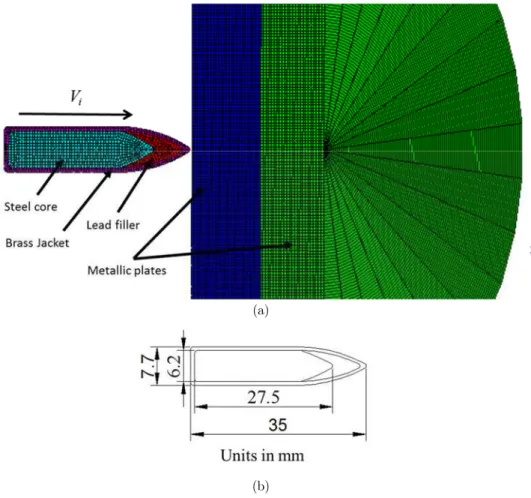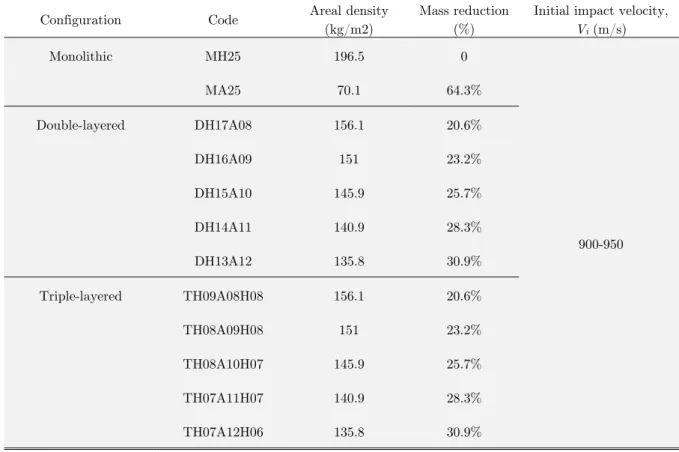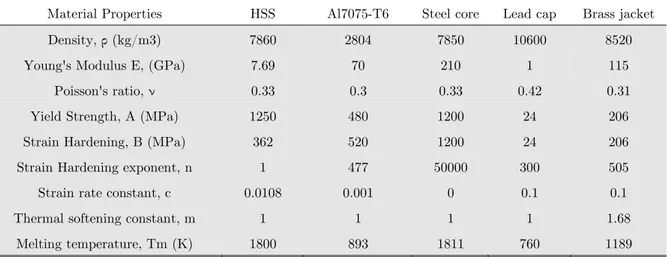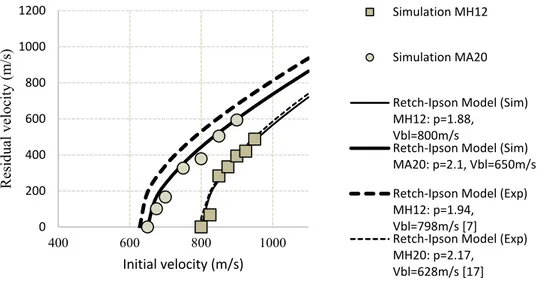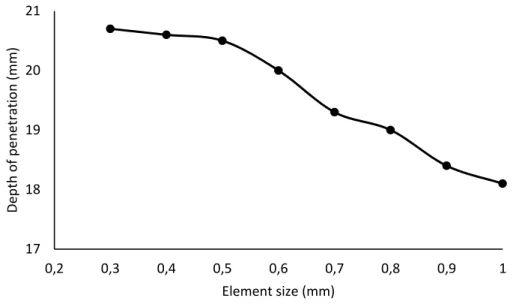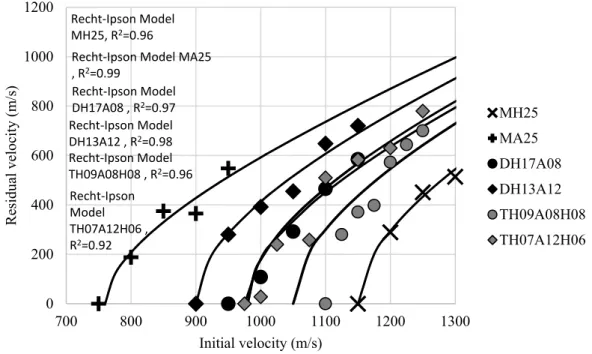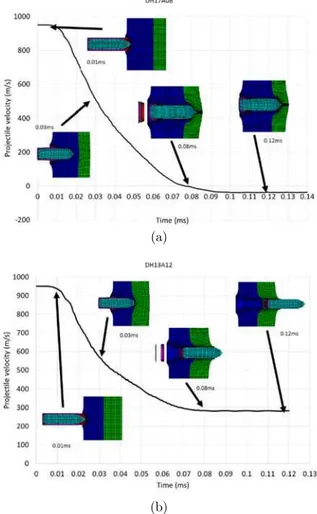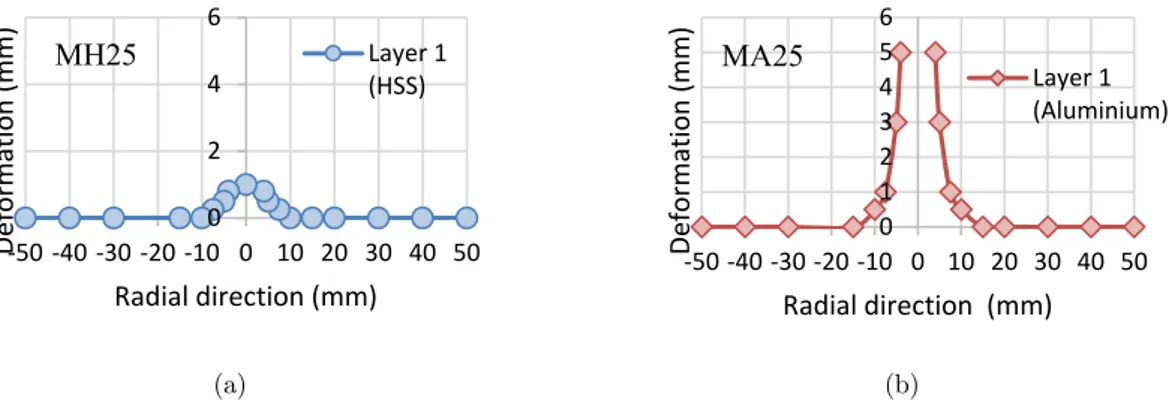Ballistic Limit of High-Strength Steel and Al7075-T6 Multi-Layered
Plates Under 7.62-mm Armour Piercing Projectile Impact
N. A. Rahman a S. Abdullah b * W. F. H. Zamri c M. F. Abdullah d M. Z. Omar e Z. Sajuri f
Department of Mechanical and Materials Engineering, Faculty of Engineering and Built Environment, Universiti
Kebangsaan Malaysia, 43600 UKM Bangi, Selangor, Malaysia. a najihah.ar@gmail.com b shahrum@ukm.edu.my c fathul@eng.ukm.my d m.faizal@upnm.edu.my e zaidiomar@ukm.edu.my f zsajuri@ukm.edu.my
*Corresponding author: shahrum@ukm.edu.my
http://dx.doi.org/10.1590/1679-78252657
Received 25.11.2015 In revised form 01.04.2016 Accepted 04.04.2016 Available online 12.04.2016 Abstract
This paper presents the computational-based ballistic limit of lam-inated metal panels comprised of high strength steel and aluminium alloy Al7075-T6 plate at different thickness combinations to neces-sitate the weight reduction of existing armour steel plate. The nu-merical models of monolithic configuration, double-layered configu-ration and triple-layered configuconfigu-ration were developed using a com-mercial explicit finite element code and were impacted by 7.62 mm armour piercing projectile at velocity range of 900 to 950 m/s. The ballistic performance of each configuration plate in terms of ballistic limit velocity, penetration process and permanent deformation was quantified and considered. It was found that the monolithic panel of high-strength steel has the best ballistic performance among all panels, yet it has not caused any weight reduction in existing ar-mour plate. As the weight reduction was increased from 20-30%, the double-layered configuration panels became less resistance to ballistic impact where only at 20% and 23.2% of weight reduction panel could stop the 950m/s projectile. The triple-layered configu-ration panels with similar areal density performed much better where all panels subjected to 20-30% weight reductions successfully stopped the 950 m/s projectile. Thus, triple-layered configurations are interesting option in designing a protective structure without sacrificing the performance in achieving weight reduction.
Keywords
1 INTRODUCTION
The recent trend in military industry is to incorporate lightweight materials into the armoured vehicle designs to reduce the vehicle weight in order to improve the fuel consumption efficiency and vehicle maneuverability, without sacrificing the performance and safety. Main criteria for an armour vehicle performance is to be able to withstand the ballistic impacts. Ballistic impact is an impact from low mass, high velocity projectile caused by a propelling source. The ballistic limit velocity is an important parameter in studying of the high velocity impact. Ballistic limit velocity is the impact velocity that gives the impactor the ability for full penetration without any residual energy (Børvik et al., 2009). Steels have been widely utilized in armour applications for their high strength and cheaper production (Übeyli et al., 2007). However, steel has restricted the mobility of armoured vehicle since it has relatively high density. This characteristic has been a disadvantage of an armour steel which has directed the researchers to find lighter materials to be integrated with existing armour steel satisfying the same level of protection (Übeyli et al., 2011).
Aluminium and its alloys offers a considerable potential for reducing the weight of an armoured vehicle body due to their high stiffness-to-weight ratio, good formability, good corrosion resistance, and recycling potential (Manes et al., 2014). The interest for aluminium alloys is not new. Several investigations have been carried out to reveal the ballistic resistance of different aluminium alloys. It has been observed that aluminium has some weaknesses compared to high strength steel when dealing with structural impact. It has lower Young’s modulus, strength and ductility. It melts at much lower temperature about 700 to 800 K, comparing to high strength steel which melts above 1800 K. Since aluminium plate have poor ballistic performance, they are often utilized in multi-layered or spaced structures, in combination of other materials. Layering aluminium plate with high strength steel has become an interest in reducing the overall density of armour vehicle body while improving the ballistic perforation resistance. It has been shown that a hard surface front layer (high strength steel) erodes the projectile into fragments and acts as disruptor to the armour system while the soft ductile inner layer (aluminium alloys) absorbs the kinetic energy through plastic deformation and prevents un-wanted projectile fragments from penetrating and acts as the absorber to the armour system. Some-times the system requires another layer acting as backing layer or cover layer in the structures.
on the behaviour of aluminium laminated composite against 7.62 AP projectiles and found that using hard material on the first layer and aluminium alloy on the back layer can improve the ballistic performance of an armour steel. An investigation conducted by Dey et al. (2004) on the ballistic resistance of Weldox 700E steel against 7.62 mm APM2 projectiles at velocity of 850 m/s shows that 12 mm monolithic layer has slightly better ballistic performance than double-layered plates with same thickness. Later on, Teng et al. (2007) found out that ballistic resistance of a multi-layered panel depends on several factors such as projectile nose shape and impact velocity, layer configuration and material properties for both projectile and plates.
The studies mentioned earlier have shown that the penetration effects of multi-layered plates are complex problem and for design purposes, the factors such as layer configurations and thickness should be well considered to obtain optimum protective structures. Since different thickness of layers would give different ballistic performance, the study for different layering configuration has become necessary. Therefore, the aim of this study is to analyse the effect of different layer configurations (monolithic, double-layered and triple-layered), total weights and initial velocities to the ballistic limit velocity, penetration process and permanent deformation under a ballistic testing against 7.62 mm APM2 projectile. A series of finite element analysis for different thicknesses of high strength steel and aluminium panels at a range of impact velocities of 900 to 950 m/s were conducted to analyse the effects.
2 METHODOLOGY
2.1 Computational Modelling
The commercial explicit finite element code ASNSYS-AUTODYN version 13 was used for all finite element modeling of projectile and target plates. A 7.62 mm APM2 projectile was used at initial velocities ranging from 700 m/s to 1200 m/s. Initial velocity was chosen according to NATO STA-NAG 4569 ballistic protection level 3 which is 930 ±20 m/s (NATO STASTA-NAG, 2004). However, decreasing and increasing the initial velocity was necessary to obtain the ballistic limit of the targets. Two material were used to design the double-layered and triple-layered target plates: HSS and Al7075-T6. The target plate was modelled as 50 mm diameter circular plate and fully clamped at the edge boundaries as in Figure 1(a). The projectile was modelled in three independent parts: Brass jacket, steel core and lead filler, and its geometries are shown in Figure 1(b). The target plate was modelled as 50 mm diameter circular plate and fully clamped at the edge boundaries.
(a)
(b)
Figure 1: (a) FEA model of 7.62mm APM2 projectile and double-layered target, (b) Geometric of projectile.
Configuration Code Areal density (kg/m2)
Mass reduction (%)
Initial impact velocity,
Vi (m/s)
Monolithic MH25 196.5 0
900-950
MA25 70.1 64.3%
Double-layered DH17A08 156.1 20.6%
DH16A09 151 23.2%
DH15A10 145.9 25.7%
DH14A11 140.9 28.3%
DH13A12 135.8 30.9%
Triple-layered TH09A08H08 156.1 20.6%
TH08A09H08 151 23.2%
TH08A10H07 145.9 25.7%
TH07A11H07 140.9 28.3%
TH07A12H06 135.8 30.9%
Table 1: Target plate configurations.
Both projectile and target panels used the Johnson-cook (JC) constitutive material model which has been commonly used for high velocity impact simulation (Kiliç and Ekici, 2013; Abdulhamid et al., 2013; Børvik et al., 2001). All projectile parts including hardened steel core, lead and brass jacket utilized the JC material constitutive model in order to avoid the stresses transmitted to the steel core were limited by the flow stress of the lead and brass jacket material because high velocity impact is affected by the temperature. The JC model is applied to determine the strain rate and temperature dependence of viscous-plastic material models and is expressed as,
m
C n eq n
eq
eq
A
B
T
*
1
1
(1)where is the equivalent stress, is the equivalent plastic strain, , , , and are the
material constants and ∗ ⁄ is the dimensionless strain rate where it is a ratio of the strain
rate and a user-defined strain rate. ∗ is the homologous temperature and is given by ∗
, where and represent the room temperature and the melting temperature,
Material Properties HSS Al7075-T6 Steel core Lead cap Brass jacket Density, ρ (kg/m3) 7860 2804 7850 10600 8520
Young's Modulus E, (GPa) 7.69 70 210 1 115
Poisson's ratio, ν 0.33 0.3 0.33 0.42 0.31 Yield Strength, A (MPa) 1250 480 1200 24 206 Strain Hardening, B (MPa) 362 520 1200 24 206 Strain Hardening exponent, n 1 477 50000 300 505 Strain rate constant, c 0.0108 0.001 0 0.1 0.1
Thermal softening constant, m 1 1 1 1 1.68
Melting temperature, Tm (K) 1800 893 1811 760 1189
Table 2: Material Properties and Modified Johnson-Cook model parameters (Abbasi et al., 2015; Forrestal et al., 2010).
2.1 Validation of FEA Model
FEA models were validated against the experiment data of Weldox 700E and Al7075-T651 from the literature. Weldox 700E was chosen to be compared with the high strength steel (HSS) used in this study because of their almost similar material properties in terms of density, Young’s modulus and Poisson’s ratio. The solid lines represent the Recht-Ipson model used to predict the residual velocity,
(Recht and Ipson, 1963),
P
Pbl P i
r
a
V
V
V
1 (2)Where and are empirical constants which best fit the data and is the ballistic limit. The
original Recht-Ipson model indicates that ⁄ and P=2, where and denote
the mass of the projectile and plug, respectively, and is applicable only if the plastic deformation of the projectile is negligible. Observations of experimental data from the literatures show that the penetration process of 7.62 mm APM2 projectile does not involve any significant plugging. Therefore,
was set as 1 and was fitted to the data trend line. The method of least squares was used to obtain
the best fit for and Vbl.
Figure 2: Comparison between experimental (Forrestal et al., 2010; Børvik et al., 2009) and predicted residual velocities.
Meshing analysis has been performed to determine the suitable mesh size for the finite element analysis. Mesh size was varied from 0.3mm to 1.0mm for the double-layered target plate and projectile as shown in Figure 3a-h. Depth of penetration for each model at initial velocity 900 m/s were evalu-ated as presented in Figure 4. The depth of penetration varies as the mesh size decreases from 1.0 mm to 0.6 mm. The variation becomes smaller as it is decreased from 0.5 mm to 0.3 mm. With taking into account the computational time, mesh size of 0.5 mm seems to be adequate for this finite element analysis.
(a) (b) (c) (d)
(e) (f) (g) (h)
Figure 3: FE models for double-layered panels at mesh size of (a) 0.3 mm (b) 0.4 mm (c) 0.5 mm (d) 0.6 mm (e) 0.7 mm (f) 0.8 mm (g) 0.9 mm (h) 1.0 mm.
400 600 800 1000
Resid
ua
l v
elo
city (m
/s)
I itial velo it /s
Si ulatio MH
Si ulatio MA
Ret h‐Ipso Model Si MH : p= . , V l= /s
Figure 4: Depth of penetration of double-layered panels DH15A10 at projectile velocity of 900 m/s for mesh size 0.3 mm to 1.0 mm.
3 COMPUTATIONAL RESULTS AND DISCUSSIONS
3.1 Effect of multi-layered on ballistic limits
The effect of multi-layered laminated panels on the ballistic performance were studied using double-layered and triple-double-layered configuration panels of HSS and Al7075-T6 plates. Monolithic configuration panels of HSS and Al7075-T6 at thickness of 25 mm were also investigated to find the ballistic resistance limitation for multi-layered made of by mixing these two materials. Panels used in this study are tabulated in Table 1. The monolithic panels of MH25 and MA25 consist of 25 mm HSS plate and 25 mm Al7075-T6 respectively. Five double-layered panels of DH17A08, DH16A09, DH15A10, DH14A11 and DH13A12 consist of 17 mm, 16 mm, 15 mm, 14 mm and 13 mm thick HSS plate as front layer, and 8 mm, 9 mm, 10 mm, 11 mm and 12 mm thick Al7075-T6 plate as back layer, respectively. Other five triple-layered panels of TH09A08A08, TH08A09H08, TH08A10H07, TH07A11H07 and TH07A12H06 consist of 9 mm, 8 mm, 8mm, 7 mm and 7 mm thick HSS plate as front layer, 8 mm, 9 mm, 10 mm, 11 mm and 12 mm thick Al7075-T6 plate as intermediate layer, and 8 mm, 8 mm, 7 mm, 7 mm and 6 mm thick HSS plate as back layer, respectively.
The trend of ballistic performances for each target plate configuration set in Table 1 can be observed in Figure 5. The highest ballistic limit came from the monolithic plate of HSS which pos-sesses the highest strength and areal density among all whereas the lowest ballistic limit came from the monolithic plate of Al7075-T6 which has the lowest strength and areal density. All ballistic limits of double-layered and triple-layered configuration panels laid between the ballistic limit of HSS and Al7075-T6. The ballistic limit of double-layered configuration panels varied for thickness differences. As the weight of 25 mm panel were reduced, the areal density of panel also reduced. This resulted in decreasing of ballistic limit from 980 m/s to 900 m/s as the weight was reduced from 20.6 % to 30.9 %. This reduction is explained by the fact that there is reduction in energy absorption capability of this
, , , , , , , ,
Depth
of peetratio
double-layered panels as the areal densities were reduced (Hou et al., 2010; Bürger et al., 2012). The same effect can be noticed from the triple-layered configuration panels. The same trend of decreasing in ballistic limits happened where they decreased from 1050 m/s to 975 m/s as the weight was reduced from 20.6% to 30.9%.
The ballistic limit for all panels were tabulated in Table 3 and Table 4. Statistically, the ballistic limit of Recht-Ipson model obtained were very convincing with R-square value of 0.92 to 0.99. The result indicates that all triple-layered panels attained higher ballistic limit compared to the double-layered panels of same areal density. The areal density affects the ballistic limit of target panel in terms of the ability of the target panel to absorb energy during impact. Panels with similar total thickness may differ in ballistic limit because of the ability of every layer constituting the multi-layered panel may differ. This indication raises an interesting issue on how the triple-multi-layered panels exhibit greater ballistic resistance than the double-layered configuration possessing the same areal density. The issue is addressed in the next section by investigating the penetration process of both configuration panels.
Figure 5: Residual velocity versus initial velocity for monolithic, double-layered and triple-layered configurations panels.
MH25 MA25 DH17A08 DH16A09 DH15A10 DH14A11 DH13A12
a 1 1 1 1 1 1 1
Vbl 1150 760 980 960 940 920 900
P 1.8 1.84 1.9 1.9 1.84 1.82 1.92
Table 3: Ballistic limit and Recht-Ipson parameters for monolithic and double-layered target configuration panels.
0 200 400 600 800 1000 1200
700 800 900 1000 1100 1200 1300
Resid ua l v elo city (m /s)
Initial velocity (m/s)
MH25 MA25 DH17A08 DH13A12 TH09A08H08 TH07A12H06
Re ht‐Ipso Model MA , R = .
Re ht‐Ipso Model MH , R = .
Re ht‐Ipso Model TH A H , R = .
Re ht‐Ipso Model TH A H , R = . Re ht‐Ipso Model DH A , R = .
TH09A08H08 TH08A09H08 TH08A10H07 TH07A11H07 TH07A12H06
a 1 1 1 1 1
Vbl 1050 1020 1020 975 975
P 2.20 2.10 1.92 1.88 1.86
Table 4: Ballistic limit and Recht-Ipson parameters for triple-layered target configuration panels.
3.2 Effect of multi-layered on penetration process
Ballistic limit result has shown that triple-layered configuration has better performance than the double-layered configuration. Figure 6(a-d) show the penetrations of monolithic of MA25 and MH25 at time of 0.07 ms. At standard initial velocity of projectile 7.62 mm APM2 of 900 m/s and 950 m/s, projectile fully penetrated MA25 with residual velocity of 365 m/s and 548 m/s respectively which can be observed in Figure 6(a) and 6(b). Meanwhile the same velocity projectile was stopped by MH25 with residual thickness of 9 mm and 7 mm respectively as illustrated in Figure 6(c) and 6(d). Combination of these two materials using double-layered and triple-layered configurations produced variation of penetration as shown in Figure 7 and Figure 8. From Figure 7(a-j), it is observed that all double-layered panels had allowed 950 m/s projectile fully penetrated and had successfully stopped 900 m/s projectile. Among all, DH17A08 and DH16A09 as in Figure 7(a) and Figure 7(c) which
possess areal density of 156 kg/m2 and 151 kg/m2 performed well at 900 m/s projectile with residual
thickness of 4 mm and 2 mm respectively. This is undeniable because both have larger areal density
compared to others and 151 kg/m2 can be the limit areal density required for double-layered to
successfully resist the 7.62 mm APM2 projectile.
(a) MA25, Vi=900 m/s
(b) MA25, Vi=950 m/s
(c) MH25, Vi= 900
(d) MH25, Vi= 950
On the other hand, triple-layered panels as in Figure 8(a-j) have shown better projectile resistance compared to the double-layered panels. For both 900 m/s and 950 m/s projectiles, all triple-layered panels had successfully stopped the projectiles and these phenomena are proved by the ballistic limit
resulting from Recht-Ipson model in Table 4. Again, panels with areal density of 156 kg/m2 and 151
kg/m2 as illustrated in Figure 8a and 8c resisted the 900 m/s projectile well with 4 mm and 3 mm
residual thickness respectively. At this state, these two triple-layered panels seem to have similar performance with the double-layered. Nevertheless, the limit of areal density for triple-layered panels
to resist the 7.62 mm APM2 projectile has increased up to 136 kg/m2 which can allow greater weight
reduction up to 30.6% compared to the double-layered panels for 23.2% only.
(a) DH17A08, Vi=900 m/s (b) DH17A08, Vi=950 m/s
(c) DH16A09, Vi=900 m/s (d) DH16A09, Vi=950 m/s
(e) DH15A10, Vi=900 m/s (f) DH15A10, Vi=950 m/s
(g) DH14A11, Vi=900 m/s (h) DH14A11, Vi=950 m/s
(i) DH13A12, Vi=900 m/s (j) DH13A12, Vi=950 m/s
(a) TH09A08H08, Vi=900 m/s (b) TH09A08H08, Vi=950 m/s
(c) TH08A09H08, Vi=900 m/s (d) TH08A09H08, Vi=950 m/s
(e) TH08A10H07, Vi=900 m/s (f) TH08A10H07, Vi=950 m/s
(g) TH07A11H07, Vi=900 m/s (h) TH07A11H07, Vi=950 m/s
(i) TH07A12H06, Vi=900 m/s (j) TH07A12H06, Vi=950 m/s
Figure 8: Penetration of projectile on triple-layered configurations at 0.07ms and initial velocity 900 m/s and 950 m/s.
APM2 projectile could have. It can be seen that the penetration processes of these panels are quite similar. As the projectile entering the thick target plate, the core penetrated into the target while the brass jacket collapsed around the core indenting the target. The target plate experienced ductile-hole formation by the steel core and the brass jacket bounced backwards without penetration leaving a crater ring around the hole. The brass jacket was energetic enough to shear off a plug around the hole and moved for some distance for time 0.03 to 0.08 ms before breaking off at 0.08 ms. Similar behaviour during penetration process can be seen in Me-bar et al. (1997). DH17A08 stopped the projectile at 0.08 ms while DH13A12 was fully perforated at 0.08 ms with residual velocity of 280 m/s. Figure 10(a) and 10(b) display the projectile velocity versus time for TH09A08H08 which has same areal density with DH17A08 and TH07A12H06 which has same areal density with DH13A12, respectively, after being impacted by 950 m/s 7.62 mm APM2 projectile. Both had successfully stopped the projectile but at different time of 0.06 ms and 0.08 ms for TH09A08H08 and TH07A12H06 respectively. The gap of performance when the weight reduced from 20.6% to 30.9% is not varied too much in triple-layered panels compared to double-layered panels. This phenomenon will be discussed further in terms of permanent deformation caused by different layering configurations in next section.
(a)
(b)
(a)
(b)
Figure 10: Penetration process of three-layered configurations (a) TH09A08H08 (20.6% mass reduction), (b) TH07A12H06 (30.9% mass reduction), for an initial projectile velocity of 900 m/s.
3.3 Effect of multi-layered on permanent deformation
shows the permanent deformation happened on 25 mm monolithic Al7075-T6 where the projectile fully perforated and caused the panel deformed about 5 mm thick. This phenomenon is supported by the fact that Al7075-T6 has more ductile and softer than the HSS (Forrestal et al., 2010; Mishra et al., 2012).
(a) (b)
Figure 11: Permanent deformation of monolithic configuration panels at initial velocity of 950m/s.
Mixing HSS and Al7075-T6 in layering form caused the permanent deformation to vary from one to another configuration. Figure 12(a) and 12(b) show that DH17A08 panel and DH16A09 are the best configuration among double-layered configuration panels which successfully stopped the 950 m/s projectile with 2mm and 3mm backing layer deformations respectively, while the rest of double-layered configuration panels as shown in Figure 10a-e failed to resist the 950 m/s projectile. For all double-layered cases, the first layer made of HSS deformed larger than second layer of Al7075-T6 because it absorbed the energy more than the second layer. As the areal density of double-layered panels was decreased, the second layer has to absorbed energy more and had caused it to deform larger. Quite similar phenomena can be seen from permanent deformation of the triple-layered when the areal density was reduced but different in the way of every layer deformed.
Figure 13 shows the permanent deformation of triple-layered configuration panels at 950 m/s projectile velocity. TH09A08H08 and TH08A09H08 as shown in Figure 13(a) and 12(b) are the best combination panels among all triple-layered configuration panels as they exhibit smaller layer defor-mations compared to others. For the rest of triple-layered configuration panels as shown in Figure 13(c-e), the first and second layers deformed at quite similar thick and radial direction because it is believed that they had fully absorbed the energy as they were capable to do. Whereas, the deformation of third layer increased as the areal density was reduced from Figure 13(a-e). The worst case for triple-layered happened at TH07A12H06 as seen in Figure 13(e) which possesses the lowest areal density and highest weight reduction. However, comparing to the same areal density and weight reduction of double-layered panel configuration DH13A12 as in Figure 12(e), it is better in term of ballistic performance. These findings show that an armour vehicle made of laminated panels of two different materials could potentially perform better than the existing armour steel plate with addi-tional attribute of having lesser weight which would enhance maneuverability.
‐ ‐ ‐ ‐ ‐Deforatio
Radial dire tio
MH25 La er
HSS
‐ ‐ ‐ ‐ ‐Deforatio
Radial dire tio
MA25 La er
(a) (b)
(c) (d)
(e)
Figure 12: Permanent deformation of double-layered configuration panels at initial velocity of 950 m/s.
‐ ‐ ‐ ‐ ‐
Deforatio
Radial dire tio
DH17A08 La er
HSS La er
Alu i iu
‐ ‐ ‐ ‐ ‐
Deforatio
Radial dire tio
DH16A09 La er HSS
La er Alu i iu
‐ ‐ ‐ ‐ ‐
Deforatio
Radial dire tio
DH15A10 La er HSS
La er Alu i iu
‐ ‐ ‐ ‐ ‐
Deforatio
Radial dire tio
DH14A11 La er HSS
La er Alu i iu
‐ ‐ ‐ ‐ ‐
Deforatio
Radial dire tio
DH A La er HSS
(a) (b)
(c) (d)
(e)
Figure 13: Permanent deformation of triple-layered configuration target panels at initial velocity of 950 m/s.
‐ ‐ ‐ ‐ ‐
Deforatio
Radial dire tio
TH09A08H08 La er HSS
La er Alu i iu La er
HSS
‐ ‐ ‐ ‐ ‐ ‐
Deforatio
Radial dire tio
TH08A09H08 La er HSS
La er Alu i iu La er HSS
‐ ‐ ‐ ‐ ‐ ‐
Deforatio
Radial dire tio
TH08A10H07 La er HSS
La er Alu i iu La er HSS
‐
‐ ‐ ‐ ‐ ‐
Deforatio
Radial dire tio
TH07A11H07 La er HSS
La er Alu i iu La er HSS
‐ ‐ ‐ ‐ ‐ ‐
Deforatio
Radial dire tio
TH A H
La er HSSLa er Alu i iu La er
4 CONCLUSIONS
In summary, the computational simulation demonstrated the capability of the FEA model developed to predict the ballistic behaviour of HSS and Al7075-T6 laminated panels and could be used for the design of experimental testing which might lead to reduction of the number of necessary tests needed for this study later on. Nevertheless, this study is still computational based and experimental valida-tion should be performed to prove the validity of the study. It was observed that the double-layered configuration panels became less resistance to ballistic impact as the weight reduction was increased from 20% to 30%, where only at 20% and 23.2% of weight reduction panel could successfully stopped the 950m/s projectile. However, with same areal density, the triple-layered configuration panels had performed 8% to 12% better than double-layered configuration. Panel TH08A09H08 with 23.2% weight reduction has the best performance among triple-layered panels with smallest depth of pene-tration of 21 mm. Thus, it is concluded that triple-layered configurations made with a combination of HSS and Al7075-T6 are interesting option for designing a protective structure as they potentially would lead to weight saving while improving the ballistic performance of the structure.
Acknowledgement
The authors wish to express their gratitude to Ministry of Higher Education Malaysia via Universiti Kebangsaan Malaysia and Universiti Pertahanan Nasional Malaysia under research funding LRGS/2013/UPNM-UKM/DS/04 for supporting this research project.
References
Abbasi, M., Reddy, S., Ghafari-Nazari, A., Fard, M. (2015). Multi-objective crashworthiness optimization of multi-cornered thin-walled sheet metal members. Thin-walled structures: 31-41
Abdulhamid, H., Kolopp, A., Bouvet, C., Rivallant, S. (2013). Experimental and numerical study of AA5086-H111 aluminum plates subjected to impact. International Journal of Impact Engineering 51:1-12.
Børvik, T., Dey, S., Clausen, A.H. (2009). Perforation resistance of five different high strength steel plates subjected to small-arms projectiles. International Journal of Impact Engineering 36:948-964.
Børvik, T., Forrestal, M.J., Hopperstad, O.S., Warren, T.L., Langseth, M. (2009). Perforation of AA5083-H116 alu-minium plates with conical-nose steel projectiles - Calculations. International Journal of Impact Engineering 36(3):426-437.
Børvik, T., Langseth, M., Hopperstad, O.S., Malo, K. (2001). A perforation of 12mm thick steel plates by 20mm diameter projectiles with flat, hemispherical and conical noses - Part I: Experimental study. International Journal of Impact Engineerig 27(1):19-35.
Bürger, D., Rocha De Faria, A., De Almeida, S.F.M., De Melo, F.C.L., Donadon, M.V. (2012). Ballistic impact simu-lation of an armour-piercing projectile on hybrid ceramic/fiber reinforced composite armours. International Journal of Impact Engineering 43:63-77
Dey, S., Børvik, T., Hopperstad, O.S., Leinum, J.R., Langseth, M. (2004). The effect of target strength on the perfo-ration of steel plates using three different projectile nose shapes. International Journal of Impact Engineering 30(8-9):1005-1038.
Forrestal, M.J., Børvik, T., Warren, T.L. (2010). Perforation of 7075-T651 Aluminum Armor Plates with 7.62 mm APM2 Bullets. Experimental Mechanics 50(8):1245-1251.
Hou, W., Zhu, F., Lu, G., Fang, D.H. (2010). Ballistic impact experiments of metallic sandwich panels with aluminium foam core. International Journal of Impact Engineering 37:1045-1055.
Kiliç, N., Ekici, B. (2013). Ballistic resistance of high hardness armor steels against 7.62 mm armor piercing ammuni-tion. Materials and Design 44:35-48.
Kiliç, N., Ekici, B. (2013). Ballistic resistance of high hardness armor steels against 7.62 mm armor piercing ammuni-tion. Materials and Design 44:35-48.
Manes, A., Serpellini, F., Pagani, M., Saponara, M., Giglio, M. (2014). Perforation and penetration of aluminium target plates by armour piercing bullets. International Journal of Impact Engineering 69:39-54.
Me-bar, Y., Rosenberg, Z. (1997). On the correlation between the ballistic behaviour and dynamic properties of tita-nium-alloy plates. International Journal of Impact Engineering 19(4): 311-318.
Mishra, B., Jena, P.K., Ramakrishna, B., Madhu, V., Bhat, T.B., Gupta, NK. (2012). Effect of tempering temperature, plate thickness and presence of holes on ballistic impact behavior and ASB formation of a high strength steel. Inter-national Journal Impact Engineering 44:17-28.
NATO STANAG 4569. Protection levels for occupants of logistic and light armored vehicles, 1st ed.; 2004.
Padersen, K.O., Børvik, T., Hopperstad, O.S. (2011). Fracture mechanisms of aluminium alloy AA7075-T651 under various loading conditions, Material and Design 32:97-107.
Ramadhan, A.A., Abu Talib, A.R., Mohd Rafie, A.S., Zahari, R. (2013). High velocity impact response of Kevlar-29/epoxy and 6061-T6 aluminum laminated panels. Materials and Design 43:307-321.
Recht, R.F., Ipson, T.W. (1963). Ballistic perforation dynamics. Journal of Applied Mechanics 30:384-390.
Sudhir Sastry, Y.B., Budarapu, P.R., Krishna, Y., Devaraj, S. (2014). Studies on ballistic impact of the composite panels. Theoretical and Applied Fracture Mechanics 72:2-12.
Teng, X., Dey, S., Børvik, T., Wierzbicki, T. (2007). Protection performance of double-layered shields against projectile impact. Journal of Mechanics of Material Structures 2:1309-1329.
Übeyli, M., Balci, E., Sarikan, B., et al. (2014). The ballistic performance of SiC-AA7075 functionally graded composite produced by powder metallurgy. Material and Design 56:31-36.
Übeyli, M., Deniz, H., Demir, T., Ögel, B., Gürel, B., Keleş, Ö. (2011). Ballistic impact performance of an armor material consisting of alumina and dual phase steel layers. Material and Design 32(3):1565-1570.
Übeyli, M., Yildirim, R.O., Ögel, B. (2007). On the comparison of the ballistic performance of steel and laminated composite armors. Material and Design 28(4):1257-1262.
